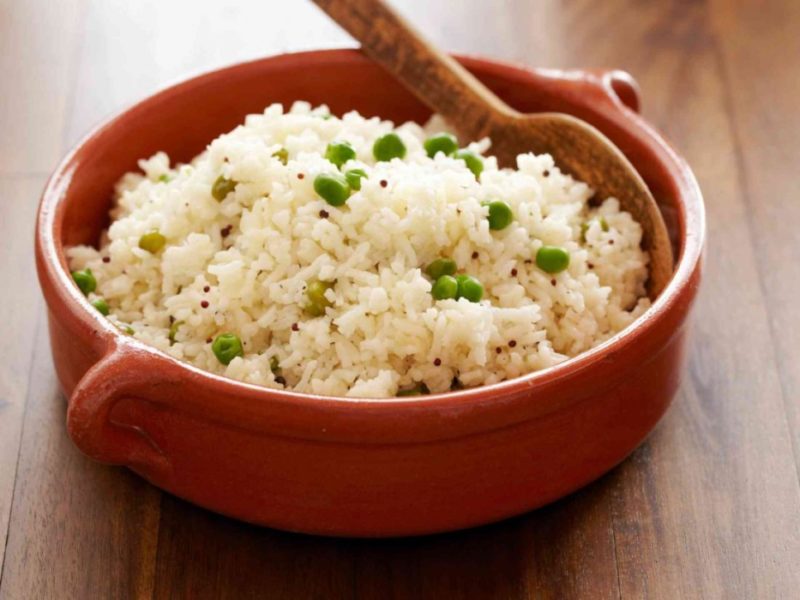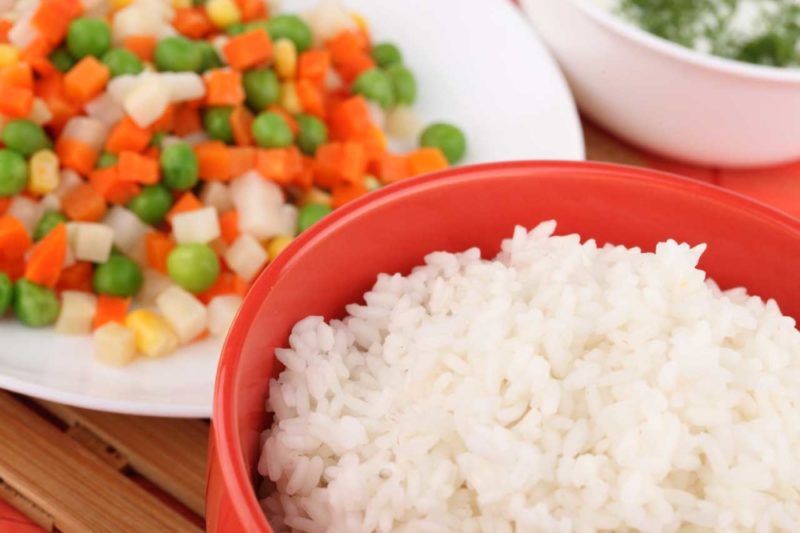Rice as a crop is widespread throughout the world and is the basis of the diet of many nations, characterized by high life expectancy and harmony. And rice porridge is one of the most beloved and popular dishes of baby and diet food. Therefore, the question of how many calories in cooked rice, and what is its nutritional value, is of interest to many people who want to find the perfect figure.
Material Content:
Chemical composition and nutritional value
Regular polished rice is high in starch and low in fiber. More than 90% of all energy per serving is carbohydrates. Fats are contained in small quantities, and although few proteins, but in terms of amino acid composition they are more complete than in other cereals.
Present in rice and water-soluble vitamins and nutrients, minerals.
Indicators per 100 g of product:
- B1 - 0.09 mg;
- B2 - 0.05 mg;
- B3 - 0.56 mg;
- B6 - 0.1 mg;
- B9 - 1.7 mg;
- H - 3.6 mg;
- calcium - 36 mg;
- potassium - 114 mg;
- iron - 1.9 mg;
- phosphorus - 32 mg;
- zinc - 1.8 mg;
- copper - 560 mcg;
- magnesium - 14 mg;
- sodium - 29 mg;
- Manganese - 3.5 mg.
Calorie content and BJU in cooked rice of different varieties
Calorie content of rice depends on two factors: its type and cooking recipe. For example, white rice is ground, so it loses some of the nutrients, but instead increases the energy supply. Total per 100 grams of dry cereal accounts for 6.5 g of protein, 0.8 g of fat and 76.5 g of carbohydrates, which is 344 kcal.
On the water
At first, the calorie content of rice seems intimidating, but you need to understand that during cooking, the grains increase in size. Therefore, to find out exactly how many calories are in boiled rice on water, you should divide the energy value of cereals into three.As a result, we get about 114 kcal per gram serving, which contains 2.1 g of protein, 0.4 g of fat and 24.9 g of carbohydrates.
Unpolished brown rice is considered the most useful, since only the upper shell is cleaned from it, while useful substances remain inside. Its calorie content in boiled form is 110 kcal in the presence of 2.6 g of protein, 0.8 g of fat and 22.8 g of carbohydrates.
Wild rice contains the fewest calories with a maximum of nutrients - 95 kcal per 100 g of the finished product, and the amount of protein is 4 g, fat - 0.3 g, and carbohydrates - 21.1 g.
Basmati contains a lot of fiber and a useful enzyme, amylase, which helps break down starches and improve the pancreas. Its calorie content in boiled form is 110 kcal per 100 g of cereal. The ratio of BZHU - 2.5 g / 0.3 g / 24.8 g.
Steamed rice is produced using a special technology. Its grains are treated with hot steam, due to which its quality is increased: vitamins and trace elements from the shell move to the core, and starch undergoes partial destruction. Such a product promotes digestion by enveloping the walls of the stomach and protecting them from the effects of hydrochloric acid. Nutrition value per 100 g of cereals: proteins - 2.9 g, fats - 0.4 g, carbohydrates - 28 g, and calorie content is only 102 kcal.
If other ingredients are added to boiled rice, its caloric content increases. Of course, we are not talking about water or salt, which have zero energy value, but a small piece of butter (3 g) will add about 20 kcal.
In milk
Rice can be used not only as a side dish, but also as a dessert or a sweet breakfast / afternoon snack. For this, cereals need to be boiled in milk, and this will increase its energy value. But since milk has a different degree of calorie content, from 31 kcal per 100 g for a low-fat product to 64 kcal at home, the energy value of the finished dish will also differ. Therefore, an accurate calculation is best done independently.
For example, take white polished rice and milk with a fat content of 2.5%. Calorie content of the products is 344 kcal and 52 kcal, respectively. We remember that cereal increases in volume by 3 times during cooking. This means that we will cook rice porridge in milk in a ratio of 1: 2, i.e., we take two parts of milk for one part of the cereal. Then the energy value of the finished dish weighing 300 g will be 448 kcal, and about 100 g of the product will have about 149 kcal.
According to the same scheme, it can be determined that the caloric content of a 100 gram portion of brown rice and basmati will be 145 kcal, wild - 130 kcal, and steamed - 137 kcal.
If you don’t want to make calculations every time, remember that milk of different fat content increases the calorie content of the dish by an average of 21-43 kcal for every 100 g, adds 1.7 g of protein, 0.1-3.6 g of fat and 3.2 g carbohydrates.
And also keep in mind that the addition of other products increases the energy value of the dish. So, a two-gram piece of butter will add 15 kcal, a teaspoon of sugar 16 kcal, and a handful of raisins will increase the calorie content by 40-50 kcal.
Daily intake
If you firmly decided to go on a diet, then the maximum daily requirement of the body for cooked rice should not exceed 300-500 g, divided into 2-3 doses. For comparison, in the East, cereal consumption is up to 600-900 g, the final indicator depends on the type of activity.
By the way, during the diet you need to adhere to the drinking regimen, drinking at least 1.5 liters of water per day. And also consume a sufficient amount of fruits or vegetables rich in fiber.
The benefits of rice porridge for the body
Rice allows not only to lose weight, but also to cleanse the body of toxins, toxins and an abundance of salts.
Its beneficial properties affect:
- Minimum salt, due to which it is useful for people with diseases of the kidneys, heart and blood vessels.
- It is rich in B-group vitamins that have a positive effect on the endocrine, cardiovascular, nervous and digestive systems.
- It does not contain gluten, which means it is not able to cause allergies.
- It contains more than 85% complex carbohydrates, so it should be included in the diet of people seeking to lose weight. Complex carbohydrates have the ability to accumulate in tissues and gradually break down, releasing energy. And the feeling of hunger is dulled at this time.
- Potassium, which is in sufficient quantities in rice, removes salts and excess fluids from the body, and also promotes metabolic processes.
- Envelops the walls of the stomach, helping in the treatment of gastritis, high acidity and ulcers.
Low calorie content and high content of beneficial organic compounds make rice a product that helps alleviate the course of chronic diseases and normalize weight.
















